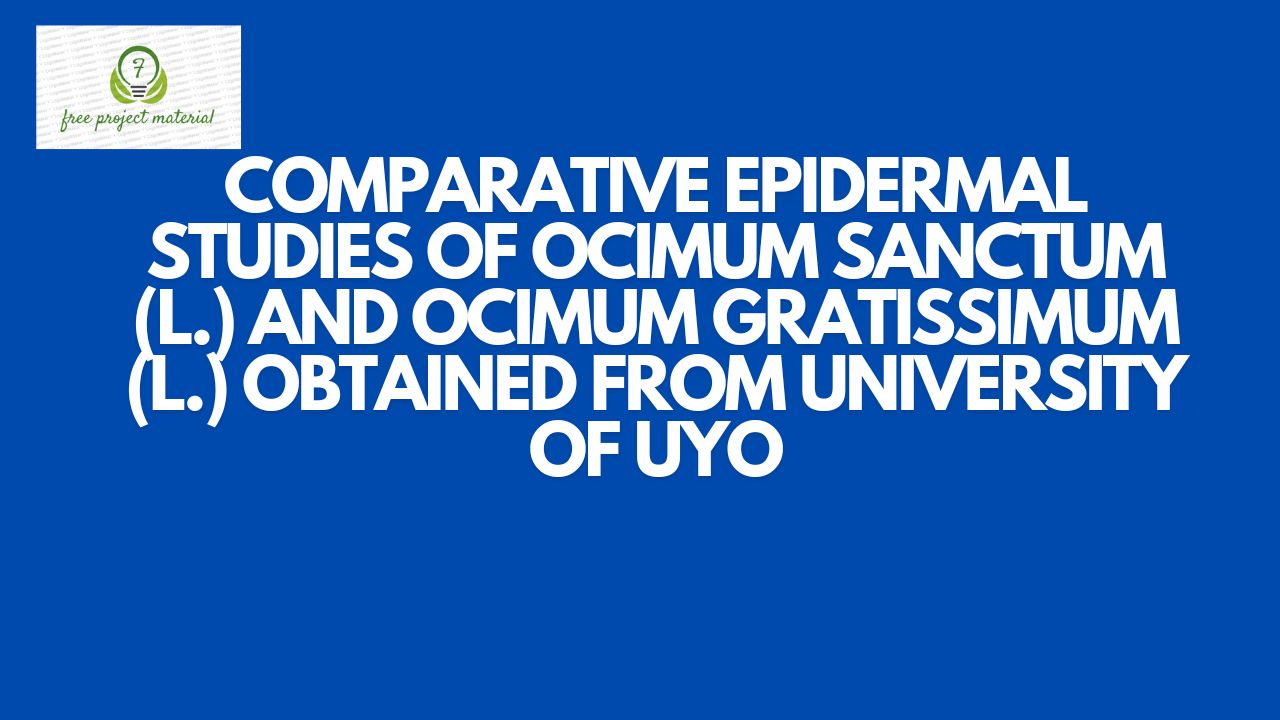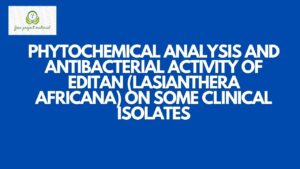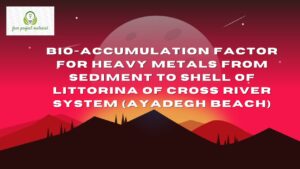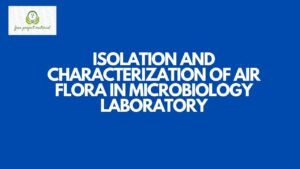ABSTRACT
In traditional systems of medicine, different parts of Ocimum have been recommended for the treatment of bronchitis, malaria, diarrhea, dysentery, skin diseases and insect bite. Epidermal characters play a vital role in plant identification and classification. In present study, comparative epidermal evaluation was performed for the flesh leaves of selected species of Ocimum such as O. gratissimum and O. sanctum. The result from microscopal characters is used for the identification of O. gratissimum and O. sanctum. The result s throws immense light on the botanical identification of various species of Ocimum which flourish a basis of judging the authenticity of the plant.
TABLE OF CONTENTS
Title Page – – – – – – – i
Declaration – – – – – – – – – ii
Certification – – – – – – – – – iii
Dedication – – – – – – – – – iv
Acknowledgements – – – – – – – v
Abstract – – – – – – – – – vi
Table of Contents – – – – – – – – vii
CHAPTER ONE
1.0 INTRODUCTION
1.1 Background of the study – – – – – – 1
1.2 Aim and Objectives of the study – – – – 3
1.2.1 Aim of the study – – – – – – – 3
1.2.2 Objectives of the study – – – – – – 3
1.3 Scope and Limitation – – – – – – 4
1.4 Definition of Terms – – – – – – 4
CHAPTER TWO
2.0 LITERATURE REVIEW
2.1 Botanical Description of Ocimum sanctum – – – 6
2.2 Scientific Classification of Ocimum sanctum – – – 6
2.3 Properties of Ocimum sanctum – – – – – 7
2.4 Traditional Uses of Ocimum sanctum – – – – 8
2.5 Phytochemical Present in Ocimum sanctum – – – 9
2.6 Pharmacological Properties of Ocimum sanctum – – 11
2.6.1 Anti-Microbial Activity – – – – – – 11
2.6.2 Anti-Fungal Activity – – – – – – 12
2.6.3 Anti-Oxidant Effect – – – – – – 13
2.6.4 Anti-Diabetic Effect – – – – – – 13
2.6.5 Anti-Carcinogenic property – – – – – 14
2.6.6 Anti-Ulcer Activity – – – – – – 15
2.6.7 Wound Healing Effect – – – – – – 15
2.7 Botanical Description of Ocimum gratissimum – – 16
2.8 Scientific Classification of Ocimum gratissimum – – 16
2.9 Properties of Ocimum gratissimum – – – – 17
2.10 Traditional Uses of Ocimum gratissimum – – – 18
2.11 Phytochemical Present in Ocimum gratissimum – – 19
2.12 Pharmacological Properties of Ocimum gratissimum – 20
2.12.1 Anti-Hypertensive Activity – – – – – 20
2.12.2 Anti-Infertility Effect – – – – – – 20
2.12.3 Nephroprotective Activity – – – – – 21
2.12.4 Anti-Microbial Activity – – – – – – 21
2.12.5 Wound Healing Properties – – – – – 22
2.12.6 Bio-Pesticide – – – – – – – 22
CHAPTER THREE
3.0 MATERIALS AND METHODS
3.1 Materials – – – – – – – – 24
3.1.1 Collection of plant sample – – – – – 25
3.2 Method – – – – – – – – 25
3.2.1 Anatomical studies – – – – – – – 25
3.2.2 Statistical analysis – – – – – – – 26
CHAPTER FOUR
4.0 RESULTS AND DISCUSSION
4.1 Results – – – – – – – – 27
4.2 Discussion – – – – – – – – 31
CHAPTER FIVE
5.0 CONCLUSION AND RECOMMENDATION
5.1 Conclusion – – – – – – – – 33
5.2 Recommendations – – – – – – – 33
References
CHAPTER ONE
1.0 INTRODUCTION
1.1 Background of the study
Medicinal plants are of great importance to human health. That is why the world health organization estimates that 80% of the populations in developing countries rely on traditional medicine for their primary health care (Nathiya et al.,2012). Therefore, medicinal plants have played an important role in the socio-cultural and therapeutic need of people. Some of these plants are used as spices and food. Medicinal plants being as a key natural resource and potentially secure drugs are contributing a significant role in mollifying human health by contributing nil side effects herbal medicines. The high cost of allopathic medicine and their potential side effects, encouraged the people to use the traditional medicine.
The ocimum (Basil) comprises some of the most popular herbs known for aromatic cuisine, medicinal, ornamental, sacred and several other aesthetic properties in the world. It belonged to the family Lamiaceae, subfamily ocimoideae and includes more than 65different species and varieties distributed in the tropical regions of Asia, Africa, central and south Africa considered as one of the largest genera of the Lamiaceae family. The name Tulsi is derived from “sanskrit’ which means “matchless one” (Ghosh, 1995; Simpson and Conner, 1986). In traditional systems of medicine, different parts (leaves, stems, flower, roots, seeds and even while plant) of ocimum have been recommended for the treatment of various ailments i.e, bronchitis, bronchial asthma, malaria, diarrhea, dysentery, skin disease, arthritis, chronic fever and insect bite.
The present study was conducted with the aim of identifying two species of Ocimum based on anatomical differences. Ocimum species show wide morphological variations, growth attributes, reproductive behavior including variations in chemical composition in relation with environmental factors (Carovic et al., 2006) because of genetic variations in their inter and intra specific variability. Advancement in classification of Ocimum was introduced (Lawrence et al., 1992). Based on essential oil compositions from the aerial parts. Chemotaxonomy can be used to differentiate the genotypes of the same species. As it generates confusions because of variation in chemical composition due to environmental influence, therefore anatomical evaluation and authentication of desired species is the easiest and cost effective method for proper identification. In this study two Ocimum species are differentiated based on morpho-chemical –anatomical characterization.
1.2 Aim and objectives of the study
1.2.1 Aim of the study
The aim of this study is;
Comparative epidermal studies of Ocimum sanctum and Ocimum gratissmum leaf.
1.2.2 Objectives of the study
The Objectives of this study is:
- To compare the epidermal characters of Ocimum sanctum and Ocimum gratissmum
- To analyze the value obtained statistically by calculating the epidermal cell length and width, and stomata length and width.
1.3 Scope and Limitation
The scope of this research work covered epidermal characteristics of the upper and lower surfaces of the Ocimum sanctum and Ocimum gratissmum leaf.
1.4 Definition of Terms
Morpho-Anatomy: the study of anatomical firms and structures with emphasis on characteristics useful in distinguishing the species.
Adaxial surface: upper surface of the leaf
Abaxial surface: lower surface of the leaf
Anticlinal wall: occurring at right angles to the surface or circumference of a plant organ anticlinal pattern of cell walls.
Epidermal Stomata: is a single layer of cells that covers the leaves, flowers, roots and stems of plants.
Hypostomatic: presence of stomata on only one surface of the leaf.
Amphistomatic: presence of stomata on both surface of the leaf.



